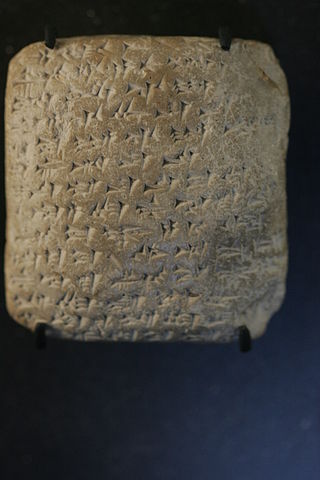Zimredda, also Zimr-Edda or Zimr-Eddi was the mayor of Sidon, in the mid 14th century BC. He is mentioned in several of the Amarna letters, in the late Rib-Hadda series, and later. He authored letters EA 144–45.
Tagi was the ruler/mayor of ancient Ginti–(Gintikirmil), of the 14th century BC Amarna letters. Tagi's name is a Hurrian hypocoristicon for the word beautiful.

The Pitati were a contingent of Nubian archers of ancient Egypt that were often requested and dispatched to support Egyptian vassals in Canaan. They are recorded in the correspondence of the 1350 BC Amarna letters, and were often requested to defend against the Habiru, also rogue vassal-kings and foreign troops of neighboring kingdoms, who were on the attack.
NIN-UR.MAH.MEŠ, or the "Lady" of the Lions, was the author of two letters to the pharaoh, the King of Ancient Egypt, in the 1350–1335 BC Amarna letters correspondence. Her name is a representation of the original written script characters of Babylonian 'Sumerograms' , "NIN- + UR.MAH + (plural:MEŠ)", and means, "woman–lion–plural", namely: "Lady Lions".. The Amarna letters are mostly written in Akkadian cuneiform, with local words/phrases/etc due to various city-states or countries.

Tahmašši, or Takhmašši, and also known by his hypocoristicon or pet name: Tahmaya, or Atahmaya was an Egyptian official to pharaoh in the 1350 BC Amarna letters correspondence. His name comes from: 'Ptah-mes', meaning Ptah-Born, or "Born of Ptah".
Šuwardata (Shuwardata), also Šuardatu, is understood by most scholars to be the king of the Canaanite city of Gath, although some have suggested that he was the 'mayor' of Qiltu, during the 1350-1335 BC Amarna letters correspondence. Šuwardata was the author of 8 letters to the Egyptian pharaoh.
Yanhamu, also Yenhamu, and Enhamu, was an Egyptian commissioner of the 1350-1335 BC Amarna letters correspondence.
Irimayašša, or Iriyamašša was an Egyptian official, of the 1350-1335 BC Amarna letters correspondence, written from a 15-20 year time period. The 2 letters that reference him are regarding Byblos/Gubla, and Ascalon, in western and southwestern Canaan.
Nuribta, also Nuribda, was a city, or city-state, located in the vicinity of Magiddo in Israel, in historical Canaan during the time of the Amarna letter correspondence, a 15 to 20 year period from about 1350 to 1335 BC.
Šuta, ("Shuta"), was an Egyptian commissioner of the 1350–1335 BC Amarna letters correspondence. The name Šuta is a hypocoristicon-(nickname/petname) for the Ancient Egyptian god Seth,.
Yapahu was a mayor/ruler of the city/city-state of Gazru of the 1350-1335 BC Amarna letters correspondence. Two other mayors of Gazru during the Amarna letters period, were Adda-danu and Milkilu.

Amarna letter EA 161, titled An Absence Explained, is a tall clay tablet letter of 8 paragraphs, with single paragraphing lines. The surface is somewhat degraded, but most cuneiform signs that remain, allow for a relative complete translation context for the letter, and the eight paragraphs. The clay tablet is no. BM 29818 at the British Museum; the number is visible at the top of the tablet, above Para I-(in black ink, the top half of the number visible).

The cuneiform qut sign, sign is found in both the 14th century BC Amarna letters and the Epic of Gilgamesh. It is a multi-use sign with 9 syllabic/alphabetic uses in the Epic of Gilgamesh; in the Amarna letters it is extremely common in the prostration formula, typical first paragraph of a letter, saying typically: "7 and 7 times,I bow down" ; a small group of Amarna letters are addressed to a different distinct personage in Egypt, under the Pharaoh.

Amarna letter EA 364, titled Justified War, is a clay tablet letter from Ayyab, ruler of Aštartu, to Pharaoh Akhenaten.

Amarna letter EA 144, titled: "Zimreddi of Sidon," is a square-shaped, mostly flat clay tablet letter written on both sides and the bottom edge. It is from a vassal state in Canaan, and is written by the 'mayor' of Sidon, the author of Amarna letter EA 144, and Amarna letter EA 145. Zimreddi is also referred to in a few other Amarna letters.

Amarna letter EA 271, titled: "The Power of the 'Apiru," is a moderately short, tallish, rectangular clay tablet letter, approximately 3 in wide x 4 in tall, from Milkilu the mayor/ruler of Gazru (Gezer), of the mid 14th century BC Amarna letters.

Amarna letter EA 323, titled: A Royal Order for Glass, is a smaller, square, mostly flat clay tablet letter written on both sides, but only half of the reverse; it is also written on the bottom, and is a letter from 'governor' Yidya, and is a short letter like many of his other Amarna letters, numbered EA 320 to EA 326.
Amarna letter EA 254, titled: "Neither Rebel nor Delinquent (2)", is a moderate length, tall, and mostly flat rectangular clay tablet Amarna letter,. The letter is from Labaya of city-state Šakmu . It is an undamaged letter, in pristine condition, with cuneiform script on almost all surfaces: Obverse, Bottom, Reverse, and Left Side. Letter EA 254 is numbered VAT 335, from the Vorderasiatisches Museum Berlin.

Amarna letter EA 290, titled: "Three Against One", is one of the two shorter letters, of six, from Abdi-Heba the governing man of Jerusalem. In the Jerusalem letters, Jerusalem is "Uru-Salem" ("City-Peace").

Amarna letter EA 299, titled: "A Plea for Help", is a fairly short clay tablet Amarna letter from "governor" Yapahu of city-state Gazru. The clay tablet surface has been partially eroded, but the cuneiform is still mostly legible.







